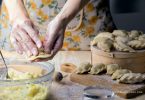Ever wonder about that baked bread and fruity smell wafting from your grandmother’s kitchen or the local church or farmer’s market? You’re in luck. Your neighborhood is either a community featuring Czech immigrant heritage, or there’s Czech immigrant descendants—or people who so thoroughly enjoy this culture and cuisine that they’re taking part in it.
Let’s start with the pronunciation, which is “ko-lah-chee.” Kolaches are made of yeast dough and usually filled with fruit, but sometimes cheese. In this installment of GeneFoods, we will explore the history of the Czech immigrants that were traveled a long, hard road—but still persisted in settling down in the United States, bringing with them the recipes to recreate their heritage.
Folding Folklore into Culture
Legend has it that in the Austro-Hungarian Empire, which is the modern-day Czech Republic, a woman named Maminka was trying to bake bread, but her daughter Lebuse, being just like our own kids, kept disrupting her. In order to get some peace and quiet, Maminka split a piece of dough from the bread for Lebuse to play with. Enjoying the newfound edible toy, Lebuse rolled and flattened her dough, then slipped in some plums from the table. Unbeknownst to her mother, she put her creation in the oven.
After some work in the fields, her father came back home for a snack. Reaching for the pieces of bread that were fresh from the oven, he picked up Lebuse’s creation, which shot out scalding plum juice as he held the pastry. Screaming in pain, Lebuse’s father began hopping around the table in a circle, much to the delight of his daughter. Finding it hilarious, Lebuse laughed, saying “Tatinek je do kola!” which meant: “Tatinek is making a wheel!”
Thus, kolache is reported to have come into this world. The pastry’s name comes from the Czech word kola which means “wheels” or “round”.
Kneading History
Originally, kolache was a semisweet dessert for traditional Czech weddings. That’s right—the tasty kolaches you may know served a far more important status than just simply filling your stomach in Czech culture. Baked a few weeks before the wedding, the smalls buns are made and then given to friends and relatives as an invitation—a rather tasty one at that. In Czech culture, kolaches should have at least three fillings in order to demonstrate the culinary art and skill of the housewife.
Over the years, the kolache would see itself making its journey from Czech to other parts of Europe, most notably South London. In Great Britain, people started seeing it as a delicious breakfast item. Nonetheless, it was still Czech immigrants that brought these yummy pastries to the United States in the mid to late nineteenth century.
By the 1870s and 1880s, kolaches had been spread throughout the Midwest and down to the Lone Star state. Through churches, fraternities, and other social-gathering events, the pastry strengthened the communal bonds as people would be reminded of their heritage with their gatherings and bazaars. But for Mimi Montgomery Irwin, the story started to change with her father, Wendel Montgomery. Following a dare from the high school football coach and local priest, Wendel would go on to create The Village Bakery, the first store on record ever to sell kolaches to the public. Irwin’s father found that the kolaches sold quite literally like hotcakes to outsiders and traveling salesmen. From there, the rest is history.
How It’s Made
Depending on your ancestry, you may have learned of kolaches in generally different forms, such as the Texan, Iowan, Minnesotan, Wisconsinite styles. Though overall, apart from the Texas kind, the rest are pretty similar.
Traditionally, kolaches are made with fruits and herbs native to Czechoslovakia, such as apricot, apple, prune, poppy seed, peach, and cherry fillings. Cheese is also a popular cultural choice, too. However, it’s nothing like cheddar or mozzarella that you might be familiar with. Lifestyles centuries ago were considerably harder than the lives we live right now, and the then frugal Czechs would use cheese curds, also known as cottage cheese, for a choice of kolache filling. Nowadays, you get more fancy and American fruity flavors, such as raspberry, cranberry, apple, and pineapple, all of which were integrated into the pastry making process to fit the palates of Americans.
That being said, while the filling may differ between regions and personal preferences, the dough of the kolache remains the same, using sugar, salt, warm water, milk, egg yolks, dry yeast, shortening, bread flour, and unsalted butter. Seems like common ingredients, right?
Variations of the Dish
The most notable variation is the klobásník or Texan kolaches. Arguably, it is even considered to be another dish by some die-hard traditional kolache fans. Similar to pigs in blankets or sausage rolls, the dish sets itself apart from those two by using the special kolache dough. Originally served with sausage only inside, the increase in popularity of the dish has seen new fillings pop up, things like ham, cheese, eggs, and peppers. Apart from the savory difference between the Texan kolache and its sweeter kolache counterparts, this is a dish that was purely invented in the US rather than brought in by immigrants.
Kolaches are an integral part of Czech immigrants and their descendants’ identities, with such an important role in their cultures, from weddings to church gatherings or simply sold as a good way to start the day. If your family speaks a bit of Czech or has its roots there, it may be worthwhile to start digging for recipes because you may find that this pastry runs in the family. And if you’re part of the group haven’t heard of kolaches before, the pastry is only getting more and more popular as it spreads out from the close-knit communities that heralded it as tradition. Cheap and easy to eat on-the-go—and most importantly, delicious—it’s time to jump on the breakfast bandwagon and explore the Czech Belt in the US to see their culture and experience their cuisines for yourself. There’s no resisting these treats.






